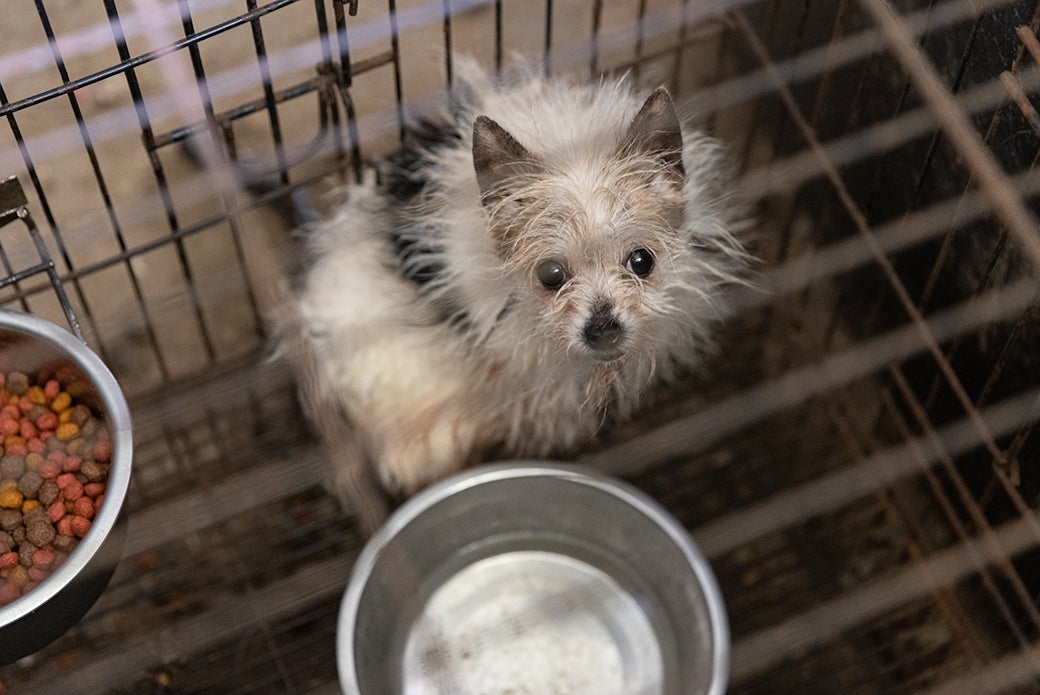

On March 30, the ASPCA assisted the Hamilton Police Department in removing nearly 30 dogs from a property in Northwest Alabama in response to an animal cruelty investigation. As Director of Field Operations for our National Field Response team, Jasmine Holsinger was one of the responders on the ground, managing the operation, and helping these dogs out of harm and toward recovery. Join Jasmine for an inside look at how the operation unfolded and her experience of helping to rescue these dogs.


I’ve been on countless operations involving similar situations as this, but no matter how much I prepare myself, it never gets easier. Each of these operations is different in one way or another but one thing is always the same: the dire need for us to intervene.
The first thing I noticed when I arrived on the property was barking coming from the animals living in enclosures outside. As my team approached the first pen, it became apparent that these dogs not only lacked clean water and a safe place to rest their head, but also appeared to be fearful and hesitant. Some were barking at us, others hid in their enclosures, while a few just stood and stared at us blankly.


The team that arrived first on the scene found that the ammonia levels in the house were at dangerous levels. As I approached the residence to take a cursory look at the animals inside, the first thing that hit me was the odor. Not just the ammonia but also an almost indescribable smell that I only experience on operations like these. That odor hits you like a wall and is so intense it feels palpable. When I entered the house, a feeling of overwhelming sadness hit me, for the animals that have had to experience these conditions. But I also felt a sense of hope: Hope for these pups, that help has arrived and that we will be doing everything in our power to help them.


All of our interactions with these animals are very unique. We understand that each has their own perception of what is going on. Some appeared fearful and hid in the back of their kennels, avoiding eye contact and trying to make themselves as small as possible. We tailor the way we interact with and handle the dogs to ensure that we are providing each individual animal with a low-stress experience, taking into account their reactions and abilities to cope with the situation.


Inevitably, some animals take more time to adjust to our presence than others. Inside the residence, there were several dogs like the small white dog above. They are the ones that really tug at my heart strings, that make that overwhelming wave of sadness wash over me and cause me to wonder how long they have been housed in these conditions.


While the dogs outside could certainly breathe fresher air than those inside the residence, they also had the burden of braving the elements. The floors were dirt mixed with urine and feces, and water bowls had what appeared to be algae growing in them.


Although the process for removing animals from these situations remains the same, we have had to adjust our safety measures to make sure we continue to keep responders safe during the COVID-19 pandemic. It’s impressive to see how flexible everyone is and how willing they are to adjust for the safety of others.


After the dogs are removed from their enclosures, they go through the animal intake process. The intake documentation is so important to the work because it identifies each individual animal, documents where they were on the property and captures specifics about the conditions in which they were living. All of this information is compiled and utilized by our evidence and investigations teams to assist the local jurisdiction in its investigation.


The medical team examines each dog as it is removed, providing any immediate medical care needed and assisting the forensics team in documenting any severe medical issues. They also are diligent in certifying that the animals are healthy enough for travel to our temporary shelter location. Throughout the removal, intake and medical processes, our handlers take the utmost care in providing consistent, low-stress handling to each individual animal.


After the intake and medical exams, our transport team prepared them for their ride to the temporary shelter. Each animal had their own clean, secure transport carrier with plenty of space to move around. Some of the dogs appeared afraid of the carriers and others went in willingly. We made sure our transport team and the temporary shelter team were aware of any special handling needs or behavior concerns so that they could provide the same individualized care we maintained throughout the field process.


Nothing prepares me for the personal experience of operations like these, no matter how many times I deploy. The sights, the smells and the sounds stick with me for a long time. But what sticks with me even more are the small moments with these animals. When you take a dog out of their cage and they lean into you, seeking comfort from your touch. When they look into your eyes and suddenly give your cheek a kiss. It’s those moments that stick with me and give me comfort and hope. I can only imagine what they are feeling in those moments too. And this is just the beginning of their journey!
Source: Read Full Article
